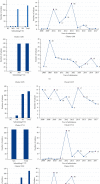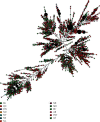Compilation of 10 Years of MIRU-VNTR Data: Canadian National Tuberculosis Laboratory's Experience
- PMID: 36046174
- PMCID: PMC9424012
- DOI: 10.1155/2022/3505142
Compilation of 10 Years of MIRU-VNTR Data: Canadian National Tuberculosis Laboratory's Experience
Abstract
Tuberculosis is a significant cause of morbidity worldwide and is a priority at the provincial and federal levels in Canada. It is known that tuberculosis transmission networks are complex and span many years as well as different jurisdictions and countries. MIRU-VNTR is a universal tuberculosis genotyping method that utilizes a 24-loci pattern and it has shown promise in identifying inter and intrajurisdictional clusters within Canada. MIRU-VNTR data collected over 10 years from the National Reference Centre for Mycobacteriology (NRCM) were analyzed in this study. Some clusters were unique to a single province/territory, while others spanned multiple provinces and/or territories in Canada. The use of a universal laboratory test can enhance contact tracing, provide geographical information on circulating genotypes, and hence, aid in tuberculosis investigation by public health. The housing of all data on one platform, technical ease of the method, easy exchange of data between jurisdictions, and strong collaboration with laboratories and surveillance units at the provincial and federal levels have the potential to identify possible outbreaks in real time.
Copyright © 2022 Meenu K. Sharma et al.
Conflict of interest statement
The authors declare that they have no conflicts of interest.
Figures





References
-
- WHO. Global Tuberculosis Report 2020 . Geneva, Switzerland: World Health Organization; 2020.
LinkOut - more resources
Full Text Sources

